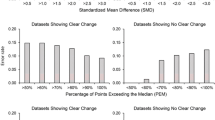Abstract
Quality-control charts can be particularly useful in identifying treatment effects and patterns of behaviors in single-subject behavior-analytic experiments that cannot be determined by visual inspection of their graphs. Using an example from the behavior analysis literature the quality-control charts identified the presence of treatment effects across phases as well as the presence of trends within and between phases. The ease of their calculations suggest use of them by behavior analysts whenever the effects of particular interventions are questionable.
Similar content being viewed by others
References
Baer, D. M. (1977). Perhaps it would be better not to know everything.Journal of Applied Behavior Analysis, 10, 167–172.
Berger, R. W., & Hart, T. H. (1986).Statistical process control: A guide for implementation. New York: Marcel Dekker, Inc.
Caulcutt, R. (1991).Statistics in research and development. New York: Chapman & Hall.
DeProspero, A., & Cohen, S. (1979). Inconsistent visual analyses of intrasubject data.Journal of Applied Behavior Analysis, 12, 573–579.
Deming, W. E. (1986).Out of the crisis. Cambridge, MA: Massachusetts Institute of Technology, Center for Advanced Engineering Study.
Duncan, A. J. (1986).Quality control and industrial statistics. Homewood, IL: Irwin.
Furlong, M. J., & Wampold, B. E. (1982). Intervention effects and relative variation as dimensions in experts' use of visual inference.Journal of Applied Behavior Analysis, 15, 415–421.
Hantula, D. A. (1995). Disciplined decision in an interdisciplinary environment: Some implications for clinical applications of statistical process control.Journal of Applied Behavior Analysis, 28, 371–377.
Hopkins, B. L. (1995). Applied behavior analysis and statistical process control?Journal of Applied Behavior Analysis, 28, 379–386.
Jones, R. R., Weinrott, M. R., & Vaught, R. S. (1978). Effects of serial dependency on the agreement between visual and statistical inference.Journal of Applied Behavior Analysis, 11, 277–283.
Kamps, D. M., Leonard, B. R., Vernon, S., Dugan, E. P., Delquadri, J. C., Gershon, B., Wade, L., & Folk, L. (1992). Teaching social skills to students with autism to increase peer interactions in an integrated first-grade classroom.Journal of Applied Behavior Analysis, 25, 281–288.
Kazdin, A. E. (1982).Single-case research designs. New York: Oxford University Press.
Kazdin, A. E. (1984). Statistical analyses for single-case experimental designs. In D. H. Barlow & M. Hersen,Single Case Experimental Designs: Strategies for studying behavior change. New York, NY: Pergamon Press.
Kratochwill, T. R., & Brody, G. H. (1978). A perspective on the controversy over employing statistical inference and implications for research and training in behavior modification.Behavior Modification, 2, 291–307.
Levi, A. S., & Mainstone, L. E. (1987). Obstacles to understanding and using statistical process control as a productivity improvement approach.Journal of Organizational Behavior Management, 9, 23–32.
Mainstone, L. E. & Levi, A. S. (1987). Fundamentals of statistical process control.Journal of Organizational Behavior Management, 9, 5–21.
Montgomery, D. C. (1985).Introduction to statistical quality control. New York: John Wiley & Sons.
Ottenbacher, K. J. (1990a). Visual inspection of single-subject data: An empirical analysis.Mental Retardation, 28, 283–290.
Ottenbacher, K. J. (1990b). When is a picture worth a thousand p values? A comparison of visual and quantitative methods to analyze single subject data.Journal of Special Education, 23, 436–449.
Ottenbacher, K. J., & Cusick, A. (1991). An empirical investigation of interrater agreement for single-subject data using graphs with and without trend lines.Journal of the Association for Persons with Severe Handicaps, 16, 48–55.
Parsonson, B. S., & Baer, D. M. (1978). The analysis and presentation of graphic data. In T. R. Kratochwill (Ed.),Single-subject research: Strategies for evaluating change (pp. 101–165). New York: Academic Press.
Parsonson, B. S., & Baer, D. M. (1986). The graphic analysis of data. In A. Poling & R. W. Fugua (Eds.),Research methods in applied behavior analysis: Issues and advances (pp. 157–186). New York: Plenum Press.
Parsonson, B. S., & Baer, D. M. (1992). The visual analysis of data, and current research into the stimuli controlling it. In T. R. Kratochwill & J. R. Levin (Eds.),Single-case research design and analysis: New directions for Psychology and education (pp. 15–40). Hillsdale NJ: Lawrence Erlbaum Associates.
Pfadt, A., Cohen, I. L., Sudhalter, V., Romanczyk, R. G., & Wheeler, D. J. (1992). Applying statistical process control to clinical data: An illustration.Journal of Applied Behavior Analysis, 25, 551–560.
Pfadt, A., Wheeler, D. J. (1995). Using statistical process control to make data-based clinical decisions.Journal of Applied Behavior Analysis, 28, 349–370.
Ryan, T. P. (1989).Statistical methods for quality improvement. New York: John Wiley & Sons.
Saunders, R. R., & Saunders, J. L. (1994). W. Edwards Deming, quality analysis, and total behavior management.The Behavior Analyst, 17, 115–125.
Sharpley, C. (1986). Fallibility in the visual assessment of behavioural interventions: Time-series statistics to analyze time-series data.Behaviour Change, 3, 26–33.
Shewhart, W. A., & Deming, W. E. (1939).Statistical method from the viewpoint of quality control. Pennsylvania, PA: Lancaster press, Inc.
Wadsworth, H. M., Stephens, K. S., & Godfrey, A. B. (1986).Modem methods for quality control and improvement. New York: John Wiley & Sons.
Wampold, B. E., & Furlong, M. J. (1981). The heuristics of visual inference.Behavioral Assessment, 3, 79–82.
Wampold, B. E., & Worsham, N. L. (1986). Randomization tests for multiple-baseline designs.Behavioral Assessment, 8, 135–143.
Wheeler, D. J., & Chambers, D. S. (1992).Understanding statistical process control. Knoxville, TN: SPC Press.
Author information
Authors and Affiliations
Rights and permissions
About this article
Cite this article
Sideridis, G.D., Greenwood, C.R. Evaluating treatment effects in single-subject behavioral experiments using quality-control charts. J Behav Educ 6, 203–211 (1996). https://doi.org/10.1007/BF02110233
Issue Date:
DOI: https://doi.org/10.1007/BF02110233




